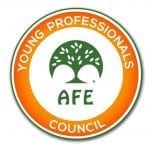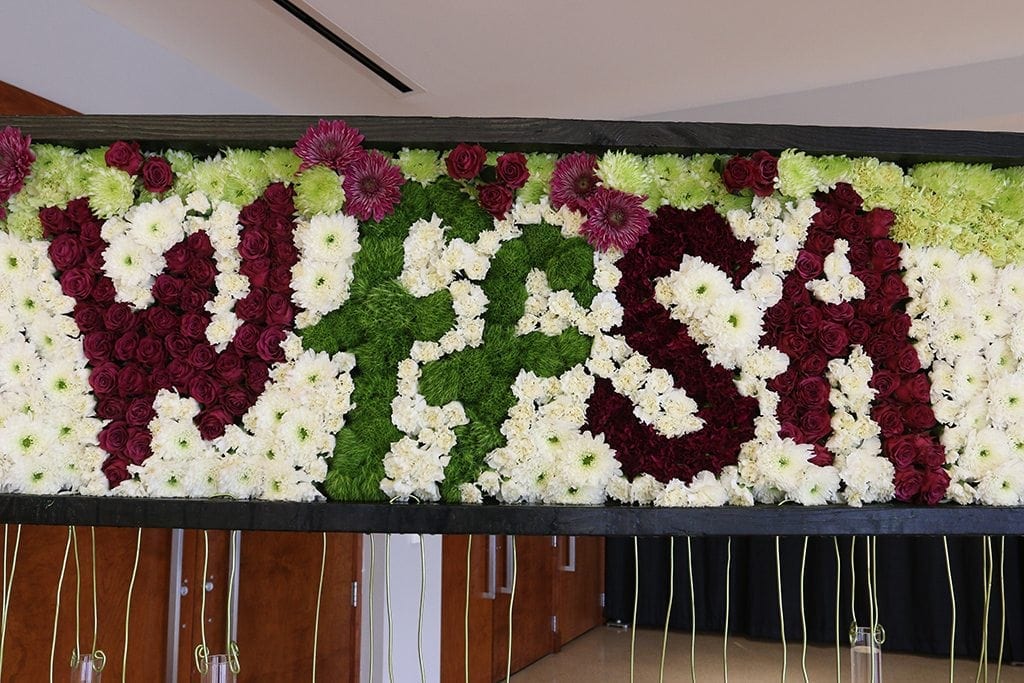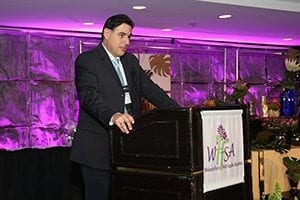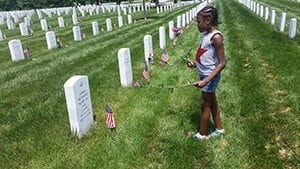
WF&FSA President Rob Shibata says that staying in tune with what makes the organization relevant to its members is critical to the organization’s continued success“We’re still here.”
“We’re still here.”
When Rob Shibata assumed the presidency of the Wholesale Florist & Florist Supplier Association on Oct. 22, he returned several times to those three words. His message? The floral industry, and wholesalers in particular, have been through a tremendous amount of change in recent years, but the businesses left standing are tougher and better for those challenging times.
“As a group, we are a tough, resilient, innovative, hard-working, adaptable, industry,” said Shibata, the president of president of Mt. Eden Floral Supply in San Jose, California, to the crowd of 780 people gathered in Miami for WF&FSA’s annual Floral Distribution Conference. “We’ve had to change as business people, and we’ve had to change as an industry. And do you know what? We’re all still here. And not only are we still here, but we are moving into the future as companies. he companies that I know are pushing into the future.

WF&FSA’s Floral Distributor Conference — with a supplier exhibition as a highlight — has increased its attendance from 120 in 2010 to 780 in 2015
In taking on the one-year term as president, Shibata followed in the footsteps of his father, Yoshimi “Shimi” Shibata, who headed WF&FSA 43 years earlier. (Shimi died on Oct. 31, 2015, just after the 2015 WF&FSA Annual Meeting.)
Three months into his term, and with the New Year ahead of WF&FSA, we asked Shibata to return to some of the points he addressed in his speech in Miami last October, elaborating on challenges and the opportunities that are ahead of the organization and the industry, including the need for more education and outreach to younger generations.
E-Brief: What do you see as your biggest challenge, as president?
Rob Shibata: biggest challenge for this year is to continue the success of the annual conference at our new venue, the Miami Airport Convention Center. It is a great venue with more meeting and exhibit space for vendors and attendees. But the space is laid out differently than before so we just need to organize the conference in the space in a way that makes sense to attendees.
EB: The 2015 conference drew 780 people, but in your speech, you noted “WF&FSA, itself, almost went off a cliff in 2010 drawing only 120 people to the convention.” What do you think accounts for the impressive turnaround?
RS: The credit goes to Gary Doran Jim Wanko, their executive committee, and the board during the 18 months they revamped the organization . (Wanko passed away in March)
That plan included several key elements that we still employ today:

Wholesalers still in business today “have shown great strength, resilience, business acumen, flexibility, and insight,” Shibata said. “They have earned the right to be in the marketplace today and should feel good about it.”
- Hold the conference at a location where the most people are likely to go. That place has been and is still Miami.
- Keep the attendee portion of the conference to two days. This reduces hotel cost and time out of the office, which reduces the impact of sending people to the conference.
- Low registration fees. The registration fee per attendee today is about 70 percent lower than the old fee structure prior to moving the conference to Miami. The WF&FSA conference might be the best value on the planet in terms of the absolute registration cost. In relative terms, it is certainly one of the best values for the networking and world class educational sessions the attendees receive.
One of the currencies for business people today is their time. Companies want their people to get the most out of whatever they spend their time on. I think the success of the conference reflects the value it represents to the members.
EB: What lessons do you draw from that turnaround as you lead the organization today?
RS: First and foremost, WF&FSA has to be relevant to it’s members which is a discussion in itself. revisit the key elements that have contributed to the success of the organization the last five years see if they need to be refreshed or updated. make change just for the sake of change evaluate programs or parts of the organization that are no longer relevant to the members or contribute to WF&FSA’s success. Can those programs be improved or do they need to be replaced with a program or service that the members value more.
EB: You mentioned in the speech that the executive committee is now taking a more “team approach.” Can you explain what you mean by that, and why it’s necessary?
RS: Each president and their respective executive committees have always taken a team approach to running the organization during his or her term. That has not changed. But the presidents are also really busy running their own companies. This means there is a practical limit to the number or scope of initiatives that any one president can accomplish during their term.
The team approach I referred to is the alignment of several successive presidents (and their executive committees) to accomplish multi-year initiatives that are important to the organization. One such initiative is to provide more value for wholesale supply buyers and engage them more in the organization. It will take more than one president’s term to evaluate, plan, and implement how to accomplish this.
EB: You also noted that the Education Committee will be presenting programming for under-40 members. Why is that group important and what kind of programming might they expect?

Shibata attributes low registration fees and a compressed schedule for the attendee growth at its annual conference. Pictured: Kevin Ylvisaker, AIFD, PFCI, a featured speaker at WF&FSA’s 2015 conference.
RS: The “under 40 group” or Emerging Leaders (EL) as we call them, are an important group for the entire floral industry for several reasons. They represent the future of our industry and the future of our individual companies as customers, buyers, sales people, managers, and owners.
As the next generation gains critical mass as consumers and as a workforce, our businesses will have to operate in ways that match or make sense to the younger generation. Operationally, they will be our teachers in terms of how the world will operate in the next 20 years. This knowledge will be necessary for each company to keep up with customers, information, and to improve efficiency.
Simple examples are the impact of Pinterest on the wedding business; web-based logistics to track everything from boxes to trucks; the use of smart phones and apps to do their jobs and communicate with customers, suppliers, and other employees.
We, the older generation, have two jobs. understand how the younger generation communicates and works, which is different from the previous generation. create ways for the older generation to pass on their experience, skills, and strategic thinking to give the younger generation the greatest chance of success. WF&FSA is evaluating a mentoring program and specific relationship building events for the EL’s as a start.
We want to increase the communication between the association and members. WF&FSA launched a blog in January and the Emerging Leaders already have a Facebook page. We have engaged with other industry associations in efforts to promote floral sales and awareness. The first of these is Women’s Day .
EB: What percentage of WFFSA’s membership falls into that younger demographic? Is that a membership area you want to grow?
RS: I do not have membership statistics for age demographics WF&FSA definitely wants to help members attract and grow the younger demographic in the industry.
EB: You mentioned road trips and the possibility of bringing WFFSA programming to other cities. Why is that a priority?
RS: The road trips and regional programs were mentioned in the context of the . Traveling to another city to visit and learn from industry colleagues is probably one of the most motivating experiences a company can give its young people. Regional programs are less expensive to attend if an attendee is from that region. In many cases, the cost to run a regional program can be reduced, which translates into lower registration fees for the attendee. SAF appears to have had great success with its regional programs , so we like to borrow from the best.
EB: “We’re all still here” is a refrain you returned to in your speech. Why is that the theme you wanted to emphasize?
RS: There has been an incredible obstacle course of changes over the last five decades. I wanted the members to pause and reflect on the fact that “we are all still here” despite those challenges. The companies operating today have shown great strength, resilience, business acumen, flexibility, and insight. They have earned the right to be in the marketplace today and should feel good about it.
EB: What would you say to someone outside of WFFSA who questioned the need for wholesalers?
RS: I would question if that person knows the true cost of distribution.
When I first came into the industry, I had a conversation about the future of the wholesale channel with Pete Garcia . Pete told me flatly “the function costs.” He went on to explain that there is a cost for every function in the supply chain, regardless of who performs that function: grower, importer, wholesaler, retailer, and now the consumer.
Here is a simple fresh flower example. Someone in the supply chain needs to take the flowers out of the grower’s box, cut the stems, and put them in water. Anyone in the supply chain can perform that function: importer, wholesaler, retailer or the consumer. But whoever does it will bear the cost and that cost needs to be built into the selling price of the product.
If someone questions the need for a wholesaler, they are saying that they can perform a wholesaler’s function as well as a wholesaler for a lower cost. If someone makes a business decision to eliminate a wholesaler, then they will need to perform the wholesaler’s function in addition to their own functions and bear the cost.
If everyone in the supply chain understood and appreciated the cost of each function, then people would spend more time building their businesses instead of trying to taking over each other’s functions.
EB: Knowing that your dad held this same position, what lessons did you learn from him that you think will help you, or continue to help you?
RS: As an association leader, be inclusive in the decision-making process. Think of the impact of each decision before moving forward. As an association, one of WF&FSA’s roles is to give companies access to products, services and programs that they wouldn’t have access to individually. The majority of floral wholesalers are family or closely held businesses. Ownership and management succession will be one of the most important keys to continuing the businesses.





